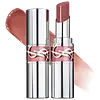What's inside
What's inside
 Key Ingredients
Key Ingredients

 Benefits
Benefits

 Concerns
Concerns

 Ingredients Side-by-side
Ingredients Side-by-side

CI 77491
Cosmetic ColorantCI 77492
Cosmetic ColorantCI 77499
Cosmetic ColorantHydrogenated Poly(C6-14 Olefin)
EmollientPolybutene
Hydrogenated Polyisobutene
EmollientPentaerythrityl Tetraethylhexanoate
EmollientTriisostearyl Citrate
EmollientEthylene/Propylene/Styrene Copolymer
Octyldodecanol
EmollientSimmondsia Chinensis Seed Oil
EmollientCocos Nucifera Oil
MaskingAroma
Tocopheryl Acetate
AntioxidantButylene/Ethylene/Styrene Copolymer
Neotame
MaskingSorbitan Oleate
EmulsifyingBenzyl Benzoate
AntimicrobialCI 77891
Cosmetic ColorantCI 15850
Cosmetic ColorantCI 42090
Cosmetic ColorantCI 77491, CI 77492, CI 77499, Hydrogenated Poly(C6-14 Olefin), Polybutene, Hydrogenated Polyisobutene, Pentaerythrityl Tetraethylhexanoate, Triisostearyl Citrate, Ethylene/Propylene/Styrene Copolymer, Octyldodecanol, Simmondsia Chinensis Seed Oil, Cocos Nucifera Oil, Aroma, Tocopheryl Acetate, Butylene/Ethylene/Styrene Copolymer, Neotame, Sorbitan Oleate, Benzyl Benzoate, CI 77891, CI 15850, CI 42090
Diisostearyl Malate
EmollientHydrogenated Polyisobutene
EmollientPhenyl Trimethicone
Skin ConditioningSynthetic Wax
AbrasiveC12-15 Alkyl Benzoate
AntimicrobialCetyl Dimethicone
EmollientOctyldodecanol
EmollientDiisopropyl Dimer Dilinoleate
EmollientPhytosteryl Macadamiate
Skin ConditioningPentaerythrityl Tetraethylhexanoate
EmollientEuphorbia Cerifera Cera Extract
Polyethylene
AbrasivePentaerythrityl Tetraisostearate
EmollientPolyglyceryl-2 Isostearate
EmulsifyingCI 77891
Cosmetic ColorantParaffin
PerfumingPassiflora Edulis Seed Oil
EmollientCera Microcristallina
Emulsion StabilisingHexadecene
SolventCI 77491
Cosmetic ColorantCI 77492
Cosmetic ColorantCI 77499
Cosmetic ColorantTocopheryl Acetate
AntioxidantCI 15850
Cosmetic ColorantPentaerythrityl Tetra-Di-T-Butyl Hydroxyhydrocinnamate
AntioxidantCaprylic/Capric Triglyceride
MaskingAluminum Hydroxide
EmollientSilica
AbrasiveTocopherol
AntioxidantFicus Carica Fruit Extract
HumectantParfum
MaskingDiisostearyl Malate, Hydrogenated Polyisobutene, Phenyl Trimethicone, Synthetic Wax, C12-15 Alkyl Benzoate, Cetyl Dimethicone, Octyldodecanol, Diisopropyl Dimer Dilinoleate, Phytosteryl Macadamiate, Pentaerythrityl Tetraethylhexanoate, Euphorbia Cerifera Cera Extract, Polyethylene, Pentaerythrityl Tetraisostearate, Polyglyceryl-2 Isostearate, CI 77891, Paraffin, Passiflora Edulis Seed Oil, Cera Microcristallina, Hexadecene, CI 77491, CI 77492, CI 77499, Tocopheryl Acetate, CI 15850, Pentaerythrityl Tetra-Di-T-Butyl Hydroxyhydrocinnamate, Caprylic/Capric Triglyceride, Aluminum Hydroxide, Silica, Tocopherol, Ficus Carica Fruit Extract, Parfum
Ingredients Explained
These ingredients are found in both products.
Ingredients higher up in an ingredient list are typically present in a larger amount.
Ci 15850 is the pigment color red. It is an azo dye and created synthetically.
Azo dyes need to be thoroughly purified before use. This allows them to be more stable and longer-lasting.
This ingredient is common in foundations, lipsticks, and blushes. This color is described as brown/orangey red.
It has many secondary names such as Red 6 and Red 7. According to a manufacturer, Red 6 usually contains aluminum.
Learn more about CI 15850Ci 77491 is also hydrated iron III oxide. It's sole purpose is to give a red/pink hue to products.
Iron III oxides are classified as inorganic chemicals for coloring.
Synthetically created Ci 77491 is considered safer than those naturally found. This is because the synthetically created version may contain less impurities. Iron oxides are generally non-toxic and non-allergenic.
Learn more about CI 77491Ci 77492 is also hydrated iron III oxide. It's sole purpose is to give a yellow hue to products.
Iron III oxides are classified as inorganic chemicals for coloring.
Synthetically created Ci 77492 is considered safer than those naturally found. This is because the synthetically created version may contain less impurities. Iron oxides are generally non-toxic and non-allergenic.
Learn more about CI 77492Ci 77499 is also hydrated iron III oxide. It is created from mixing red and black iron oxides. This helps give shades of darkness to a product.
Iron III oxides are classified as inorganic chemicals for coloring.
Ci 77891 is a white pigment from Titanium dioxide. It is naturally found in minerals such as rutile and ilmenite.
It's main function is to add a white color to cosmetics. It can also be mixed with other colors to create different shades.
Ci 77891 is commonly found in sunscreens due to its ability to block UV rays.
Learn more about CI 77891Hydrogenated Polyisobutene is a synthetic polymer. Polymers are compounds with high molecular weight. Hydrogenated Polyisobutene is an emollient and texture enhancer.
In one study, Hydrogenated Polyisobutene showed better skin hydration levels than Caprylic/Capric Triglyceride. As an emollient, it helps keep your skin soft and hydrated by trapping moisture in.
Hydrogenated Polyisobutene is often used as a mineral oil replacement.
Learn more about Hydrogenated PolyisobuteneOctyldodecanol is a fatty alcohol. It is primarily used to enhance the texture of products.
As an emulsifier, Octyldodecanol helps prevent the oils and waters from separating. It also prevents ingredients from creating foam when shaken.
Octyldodecanol is created by reducing fatty acid to an alcohol.
Due to its high molecular weight, it does not get absorbed into the skin.
Learn more about OctyldodecanolPentaerythrityl Tetraethylhexanoate is an emollient that helps make your skin smooth and hydrated. It specializes in creating a non-oily and "wet" feeling on skin.
This ingredient comes from isostearic acid, a saturated fatty acid. It is a synthetic ingredient.
Tocopheryl Acetate is AKA Vitamin E. It is an antioxidant and protects your skin from free radicals. Free radicals damage the skin by breaking down collagen.
One study found using Tocopheryl Acetate with Vitamin C decreased the number of sunburned cells.
Tocopheryl Acetate is commonly found in both skincare and dietary supplements.
Learn more about Tocopheryl Acetate